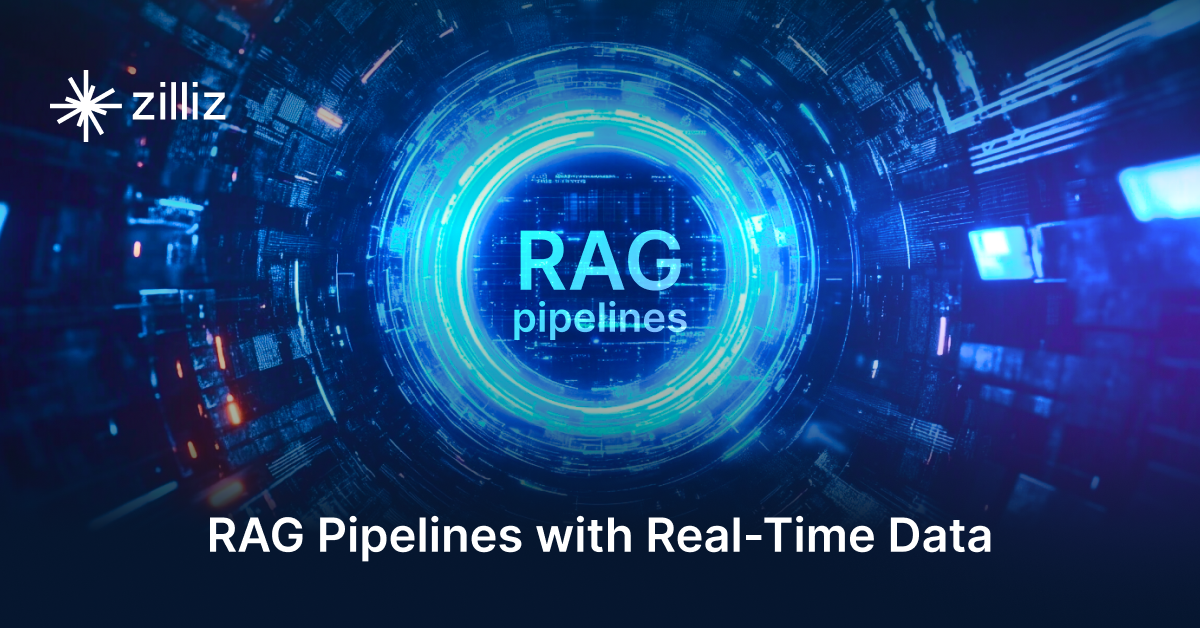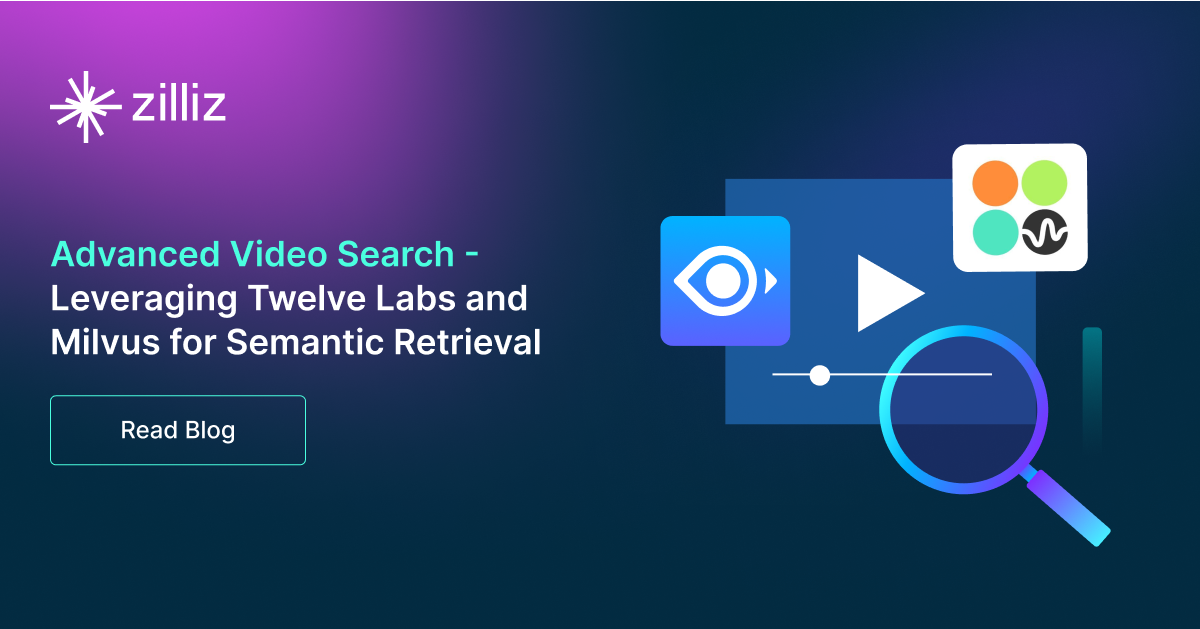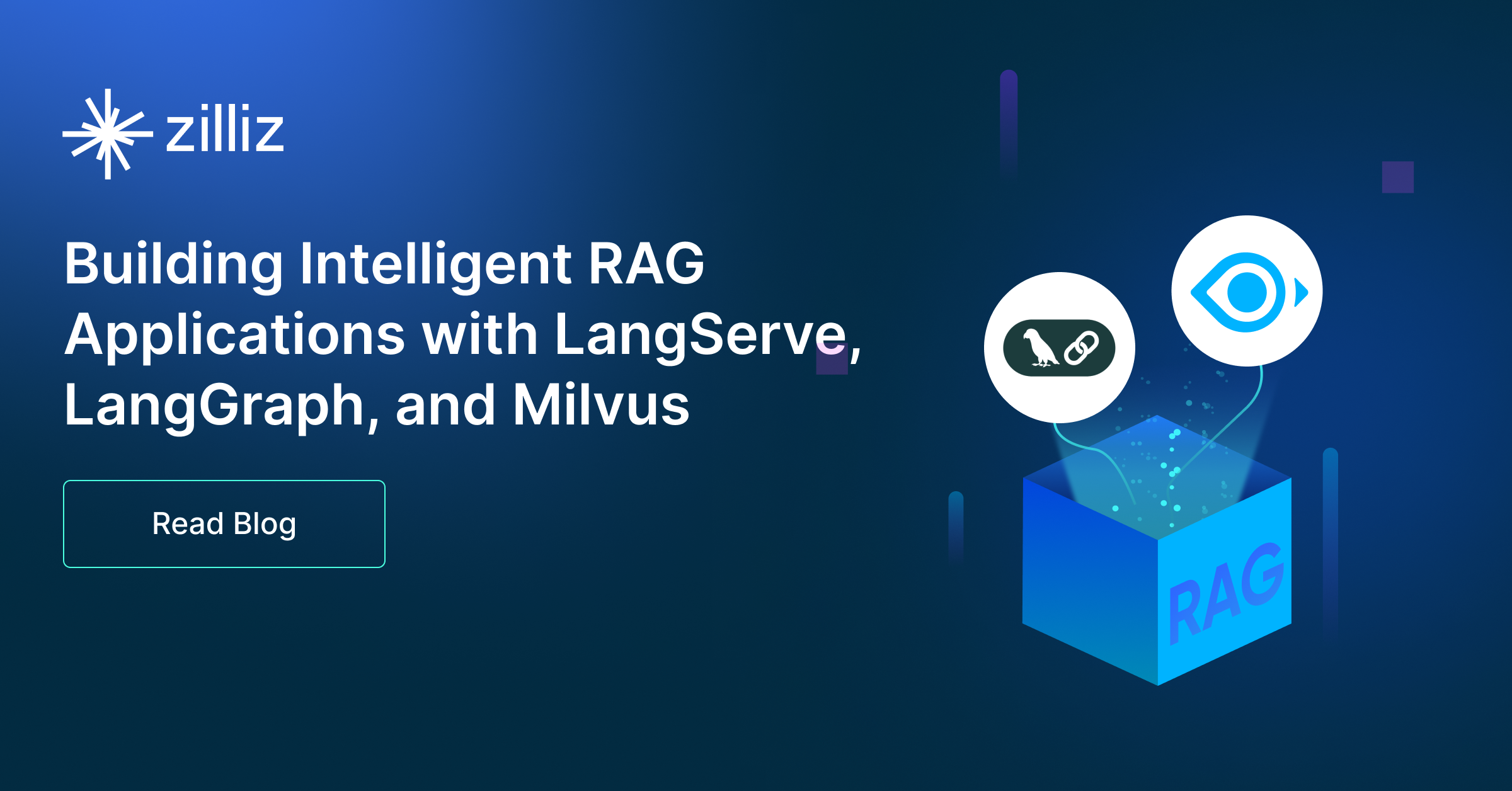Build RAG Chatbot with Haystack, Haystack In-memory store, OpenAI GPT-4o, and HuggingFace all-mpnet-base-v2
Introduction to RAG
Retrieval-Augmented Generation (RAG) is a game-changer for GenAI applications, especially in conversational AI. It combines the power of pre-trained large language models (LLMs) like OpenAI’s GPT with external knowledge sources stored in vector databases such as Milvus and Zilliz Cloud, allowing for more accurate, contextually relevant, and up-to-date response generation. A RAG pipeline usually consists of four basic components: a vector database, an embedding model, an LLM, and a framework.
Key Components We'll Use for This RAG Chatbot
This tutorial shows you how to build a simple RAG chatbot in Python using the following components:
- Haystack: An open-source Python framework designed for building production-ready NLP applications, particularly question answering and semantic search systems. Haystack excels at retrieving information from large document collections through its modular architecture that combines retrieval and reader components. Ideal for developers creating search applications, chatbots, and knowledge management systems that require efficient document processing and accurate information extraction from unstructured text.
- Haystack in-memory store: a very simple, in-memory document store with no extra services or dependencies. It is great for experimenting with Haystack, and we do not recommend using it for production. If you want a much more scalable solution for your apps or even enterprise projects, we recommend using Zilliz Cloud, which is a fully managed vector database service built on the open-source Milvusand offers a free tier supporting up to 1 million vectors.)
- OpenAI GPT-4o: A multimodal AI model optimized for advanced natural language processing, image understanding, and audio analysis. It excels in real-time interactions, offering high accuracy, contextual awareness, and seamless integration across diverse inputs. Ideal for dynamic applications like interactive customer support, content generation, multilingual translation, and complex data synthesis in industries requiring rapid, adaptive AI solutions.
- HuggingFace all-mpnet-base-v2: A versatile sentence-transformers model optimized for generating high-quality semantic embeddings. Leveraging MPNet's masked and permuted pretraining, it excels in capturing nuanced text semantics, offering robust performance in multilingual and domain-specific tasks. Ideal for semantic search, text clustering, similarity comparison, and information retrieval due to its efficiency and accuracy.
By the end of this tutorial, you’ll have a functional chatbot capable of answering questions based on a custom knowledge base.
Note: Since we may use proprietary models in our tutorials, make sure you have the required API key beforehand.
Step 1: Install and Set Up Haystack
import os
import requests
from haystack import Pipeline
from haystack.components.converters import MarkdownToDocument
from haystack.components.preprocessors import DocumentSplitter
from haystack.components.writers import DocumentWriter
Step 2: Install and Set Up OpenAI GPT-4o
To use OpenAI models, you need to get an OpenAI API key. The Haystack integration with OpenAI models uses an OPENAI_API_KEY environment variable by default. Otherwise, you can pass an API key at initialization with api_key:
generator = OpenAIGenerator(api_key=Secret.from_token("<your-api-key>"), model="gpt-4o-mini")
Then, the generator component needs a prompt to operate, but you can pass any text generation parameters valid for the openai.ChatCompletion.create method directly to this component using the generation_kwargs parameter, both at initialization and to run() method. For more details on the parameters supported by the OpenAI API, refer to the OpenAI documentation.
Now let's install and set up OpenAI models.
from haystack.components.generators import OpenAIGenerator
generator = OpenAIGenerator(model="gpt-4o", api_key=Secret.from_token("<your-api-key>"))
Step 3: Install and Set Up HuggingFace all-mpnet-base-v2
Haystack'sHuggingFaceAPITextEmbedder can be used to embed strings with different Hugging Face APIs:
The component uses a HF_API_TOKEN environment variable by default. Otherwise, you can pass a Hugging Face API token at initialization with token – see code examples below. The token is needed:
- If you use the Serverless Inference API, or
- If you use Inference Endpoints.
Here, in this tutorial, we'll use the Free Serverless Inference API. Let's install and set up the model.
To use this API, you need a free Hugging Face token. The Embedder expects the model in api_params.
from haystack.components.embedders import HuggingFaceAPITextEmbedder
from haystack.utils import Secret
from haystack.components.embedders import HuggingFaceAPIDocumentEmbedder
from haystack.dataclasses import Document
text_embedder = HuggingFaceAPITextEmbedder(api_type="serverless_inference_api",
api_params={"model": "sentence-transformers/all-mpnet-base-v2"},
token=Secret.from_token("<your-api-key>"))
document_embedder = HuggingFaceAPIDocumentEmbedder(api_type="serverless_inference_api",
api_params={"model": "sentence-transformers/all-mpnet-base-v2"},
token=Secret.from_token("<your-api-key>"))
Step 4: Install and Set Up Haystack In-memory store
from haystack.document_stores.in_memory import InMemoryDocumentStore
from haystack.components.retrievers import InMemoryEmbeddingRetriever
document_store = InMemoryDocumentStore()
retriever=InMemoryEmbeddingRetriever(document_store=document_store))
Step 5: Build a RAG Chatbot
Now that you’ve set up all components, let’s start to build a simple chatbot. We’ll use the Milvus introduction doc as a private knowledge base. You can replace it your own dataset to customize your RAG chatbot.
url = 'https://raw.githubusercontent.com/milvus-io/milvus-docs/refs/heads/v2.5.x/site/en/about/overview.md'
example_file = 'example_file.md'
response = requests.get(url)
with open(example_file, 'wb') as f:
f.write(response.content)
file_paths = [example_file] # You can replace it with your own file paths.
indexing_pipeline = Pipeline()
indexing_pipeline.add_component("converter", MarkdownToDocument())
indexing_pipeline.add_component("splitter", DocumentSplitter(split_by="sentence", split_length=2))
indexing_pipeline.add_component("embedder", document_embedder)
indexing_pipeline.add_component("writer", DocumentWriter(document_store))
indexing_pipeline.connect("converter", "splitter")
indexing_pipeline.connect("splitter", "embedder")
indexing_pipeline.connect("embedder", "writer")
indexing_pipeline.run({"converter": {"sources": file_paths}})
# print("Number of documents:", document_store.count_documents())
question = "What is Milvus?" # You can replace it with your own question.
retrieval_pipeline = Pipeline()
retrieval_pipeline.add_component("embedder", text_embedder)
retrieval_pipeline.add_component("retriever", retriever)
retrieval_pipeline.connect("embedder", "retriever")
retrieval_results = retrieval_pipeline.run({"embedder": {"text": question}})
# for doc in retrieval_results["retriever"]["documents"]:
# print(doc.content)
# print("-" * 10)
from haystack.utils import Secret
from haystack.components.builders import PromptBuilder
retriever=InMemoryEmbeddingRetriever(document_store=document_store)
text_embedder = HuggingFaceAPITextEmbedder(api_type="serverless_inference_api",
api_params={"model": "sentence-transformers/all-mpnet-base-v2"},
token=Secret.from_token("<your-api-key>"))
prompt_template = """Answer the following query based on the provided context. If the context does
not include an answer, reply with 'I don't know'.\n
Query: {{query}}
Documents:
{% for doc in documents %}
{{ doc.content }}
{% endfor %}
Answer:
"""
rag_pipeline = Pipeline()
rag_pipeline.add_component("text_embedder", text_embedder)
rag_pipeline.add_component("retriever", retriever)
rag_pipeline.add_component("prompt_builder", PromptBuilder(template=prompt_template))
rag_pipeline.add_component("generator", generator)
rag_pipeline.connect("text_embedder.embedding", "retriever.query_embedding")
rag_pipeline.connect("retriever.documents", "prompt_builder.documents")
rag_pipeline.connect("prompt_builder", "generator")
results = rag_pipeline.run({"text_embedder": {"text": question}, "prompt_builder": {"query": question},})
print('RAG answer:\n', results["generator"]["replies"][0])
Optimization Tips
As you build your RAG system, optimization is key to ensuring peak performance and efficiency. While setting up the components is an essential first step, fine-tuning each one will help you create a solution that works even better and scales seamlessly. In this section, we’ll share some practical tips for optimizing all these components, giving you the edge to build smarter, faster, and more responsive RAG applications.
Haystack optimization tips
To optimize Haystack in a RAG setup, ensure you use an efficient retriever like FAISS or Milvus for scalable and fast similarity searches. Fine-tune your document store settings, such as indexing strategies and storage backends, to balance speed and accuracy. Use batch processing for embedding generation to reduce latency and optimize API calls. Leverage Haystack's pipeline caching to avoid redundant computations, especially for frequently queried documents. Tune your reader model by selecting a lightweight yet accurate transformer-based model like DistilBERT to speed up response times. Implement query rewriting or filtering techniques to enhance retrieval quality, ensuring the most relevant documents are retrieved for generation. Finally, monitor system performance with Haystack’s built-in evaluation tools to iteratively refine your setup based on real-world query performance.
Haystack in-memory store optimization tips
Haystack in-memory store is just a very simple, in-memory document store with no extra services or dependencies. We recommend that you just experiment it with RAG pipeline within your Haystack framework, and we do not recommend using it for production. If you want a much more scalable solution for your apps or even enterprise projects, we recommend using Zilliz Cloud, which is a fully managed vector database service built on the open-source Milvusand offers a free tier supporting up to 1 million vectors
OpenAI GPT-4o optimization tips
To optimize OpenAI GPT-4o in a RAG setup, structure inputs with concise, context-rich prompts and preprocess retrieved documents to remove noise. Use metadata filtering to prioritize relevant sources and limit context length to avoid token waste. Fine-tune retrieval models to align with GPT-4o’s strengths, employ chunking with overlap for continuity, and experiment with temperature and max_token settings for balanced creativity and focus. Cache frequent queries and implement rate limiting to manage costs. Regularly evaluate outputs to refine retrieval and generation alignment.
HuggingFace all-mpnet-base-v2 optimization tips
To optimize the all-mpnet-base-v2 model in a RAG setup, preprocess input text by removing noise, truncating to the 384-token limit, and splitting documents into contextually coherent chunks. Use cosine similarity for retrieval, as the model is fine-tuned for this metric. Batch embedding generation improves throughput, while leveraging GPU acceleration reduces latency. Fine-tune the model on domain-specific data for better relevance. Index embeddings with FAISS or HNSW for efficient nearest-neighbor searches, and experiment with chunk overlap to balance context retention and redundancy.
By implementing these tips across your components, you'll be able to enhance the performance and functionality of your RAG system, ensuring it’s optimized for both speed and accuracy. Keep testing, iterating, and refining your setup to stay ahead in the ever-evolving world of AI development.
RAG Cost Calculator: A Free Tool to Calculate Your Cost in Seconds
Estimating the cost of a Retrieval-Augmented Generation (RAG) pipeline involves analyzing expenses across vector storage, compute resources, and API usage. Key cost drivers include vector database queries, embedding generation, and LLM inference.
RAG Cost Calculator is a free tool that quickly estimates the cost of building a RAG pipeline, including chunking, embedding, vector storage/search, and LLM generation. It also helps you identify cost-saving opportunities and achieve up to 10x cost reduction on vector databases with the serverless option.
 Calculate your RAG cost
Calculate your RAG cost
What Have You Learned?
Wow, you’ve just unlocked the magic of building a RAG system from the ground up! By diving into this tutorial, you’ve discovered how to seamlessly integrate four powerhouse tools: Haystack as your flexible framework, Haystack’s In-memory Store for lightning-fast vector storage, OpenAI’s GPT-4o as your creative LLM brain, and HuggingFace’s all-mpnet-base-v2 embedding model to turn text into rich numerical representations. You’ve seen how these pieces fit together like a well-oiled machine—transforming raw data into searchable vectors, retrieving context with precision, and generating human-like answers that feel almost magical. Along the way, you learned to optimize your pipeline by tweaking chunk sizes, adjusting similarity thresholds, and balancing speed with accuracy. And let’s not forget the cherry on top: that free RAG cost calculator you explored, which helps you estimate expenses and make smarter decisions about scaling your projects without breaking the bank.
But this isn’t just about following steps—it’s about opening doors. You now have the toolkit to build applications that understand context, answer complex questions, and even surprise users with their depth. Imagine creating chatbots that feel alive, research assistants that sift through mountains of data in seconds, or personalized recommendation engines that adapt in real time. The sky’s the limit! So what’s next? Take these insights, experiment fearlessly, and iterate. Swap out components, test new embedding models, or integrate different databases. Remember, every tweak is a step toward innovation. The world of RAG is evolving fast, and you’re now part of the wave shaping it. Ready to make an impact? Start building, keep optimizing, and let your creativity soar—your next breakthrough is just a few lines of code away! 🚀
Further Resources
🌟 In addition to this RAG tutorial, unleash your full potential with these incredible resources to level up your RAG skills.
- How to Build a Multimodal RAG | Documentation
- How to Enhance the Performance of Your RAG Pipeline
- Graph RAG with Milvus | Documentation
- How to Evaluate RAG Applications - Zilliz Learn
- Generative AI Resource Hub | Zilliz
We'd Love to Hear What You Think!
We’d love to hear your thoughts! 🌟 Leave your questions or comments below or join our vibrant Milvus Discord community to share your experiences, ask questions, or connect with thousands of AI enthusiasts. Your journey matters to us!
If you like this tutorial, show your support by giving our Milvus GitHub repo a star ⭐—it means the world to us and inspires us to keep creating! 💖
- Introduction to RAG
- Key Components We'll Use for This RAG Chatbot
- Step 1: Install and Set Up Haystack
- Step 2: Install and Set Up OpenAI GPT-4o
- Step 3: Install and Set Up HuggingFace all-mpnet-base-v2
- Step 4: Install and Set Up Haystack In-memory store
- Step 5: Build a RAG Chatbot
- Optimization Tips
- RAG Cost Calculator: A Free Tool to Calculate Your Cost in Seconds
- What Have You Learned?
- Further Resources
- We'd Love to Hear What You Think!
Content
Vector Database at Scale
Zilliz Cloud is a fully-managed vector database built for scale, perfect for your RAG apps.
Try Zilliz Cloud for Free


